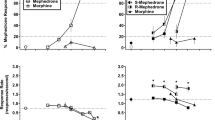Abstract
The discriminative stimulus properties of (+)-lysergic acid diethylamide (LSD) and lisuride hydrogen maleate (LHM), were compared in a three-choice, water reinforced (FR 20) situation in which rats were required to press one lever following LSD (0.08 mg/kg), a second lever following LHM (0.04 mg/kg), and a third lever following saline. Reliable drug-appropriate responding was established in 72 sessions. Dose-response tests with LSD and LHM indicated that, as dose increased, the per cent of responding on the lever associated with the particular training drug also increased; little or no cross-transfer occurred between LSD and LHM. In generalization tests, the serotonin (5-HT) agonist quipazine substituted for LSD but not LHM while the dopamine (DA) agonist apomorphine mimicked LHM but not LSD; an unrelated compound, pentylenetetrazol (PTZ), produced responding on the saline-appropriate lever. In combination tests, 5-HT antagonists (e.g., BC-105 and low doses of pirenperone) blocked responding on the LSD lever while DA antagonists (e.g., haloperidol and much higher doses of pirenperone) blocked LHM-appropriate responding. These data suggest that the three-lever (D-D-N) procedure is similar to, but can be more sensitive than the two-lever (D-N) procedure (because it can differentiate between LSD and LHM); they therefore at least partially support the hypothesis that three-choice discriminations can be conceptualized as two separate, two-choice (D-N) discriminations (Jarbe and Swedberg 1982). The results also confirm suggestion that the stimulus effects of LSD and LHM are mediated by different mechanisms; the primary action of LSD is serotonergic (5-HT2), while that of LHM is dopaminergic (White 1986).
Similar content being viewed by others
References
Appel JB, White FJ, Holohean AM (1982) Analyzing mechanism(s) of drug action with drug discrimination procedures. Neurosci Biobehav Rev 6:529–536
Barry H III (1974) Classification of drugs according to their discriminable effects in rats. Fed Proc 33:1814–1824
Colpaert FC, Slangen JL (eds) (1982) Drug discrimination. Applications in CNS pharmacology. Elsevier/North-Holland Biomedical Press, Amsterdam
Cunningham KA, Appel JB (1987) Neuropharmacological reassessment of the discriminative stimulus properties ofd-lysergic acid diethylamide (LSD). Psychopharmacology 91:67–73
Cunningham KA, Callahan PM, Appel JB (1984) Discriminative stimulus properties of lergotrile. J Pharmacol Exp Ther 230:47–52
Cunningham KA, Callahan PM, Appel JB (1987) Discriminative stimulus properties of lisuride revisited. Involvement of dopamine D2 receptors. J Pharmacol Exp Ther 241:147–151
Extance K, Goudie AJ (1981) Inter-animal olfactory cues in operant drug discrimination procedures in rats. Psychopharmacology 73:363–371
France CP, Woods JH (1985) Opiate agonist-antagonist interactions. Application of a three-key drug discrimination procedure. J Pharmacol Exp Ther 234:81–89
Honig WK, Urcuioli PJ (1981) The legacy of Guttman and Kalish (1956) Twenty-five years of research on stimulus generalization. J Exp Anal Behav 36:405–445
Jarbe TUC, Swedberg MDB (1982) A conceptualization of drug discrimination learning. In: Colpaert FC, Slangen JL (eds) Drug discrimination. Applications in CNS pharmacology. Elsevier/Biomedical Press, Amsterdam, pp 327–341
Leberer MR, Fowler SC (1977) Drug discrimination and generalization in pigeons. Pharmacol Biochem Behav 7:483–486
Overton DA (1967) Differential responding in a three choice maze controlled by three drug states. Psychopharmacologia 11:376–378
Overton DA (1978) Influence of training compartment design on performance in the two-bar drug discrimination task: a methodological report. In: Colpaert FC, Rosecrans JA (eds) Stimulus properties of drugs: ten years of progress. Elsevier/North Holland Biomedical Press, Amsterdam, pp 265–278
Swedberg MDB, Jarbe TUC (1985) Drug discrimination procedures: roles of relative stimulus control in two-drug cases. Psychopharmacology 86:444–451
Swedberg MDB, Jarbe TUC (1986) Drug discrimination procedures: Differential characteristics of the drug A vs drug B and the drug A vs drug B vs no drug cases. Psychopharmacology 90:341–346
White FJ (1986) Comparative effects of LSD and lisuride: clues to specific hallucinogenic drug actions. Pharmacol Biochem Behav 24:365–379
White FJ, Appel JB (1982a) Training dose as a factor in LSD-saline discrimination. Psychopharmacology 76:20–25
White FJ, Appel JB (1982b) The role of dopamine and serotonin in the discriminative stimulus effects of lisuride. J Pharmacol Exp Ther 221:421–427
White FJ, Appel JB (1982c) LSD and lisuride: differentiation of their neuropharmacological actions. Science 216:535–537
White JM, Holtzman SG (1981) Three-choice drug discrimination in the rat: morphine, cyclazocine and saline. J Pharmacol Exp Ther 217:254–262
White JM, Holtzman SG (1983) Three-choice drug discrimination: phencyclidine-like stimulus effects of opioids. Psychopharmacology 80:1–9
Author information
Authors and Affiliations
Additional information
Some of these data were presented at the meeting of the Society of Neuroscience, Toronto, 1988 (Satellite Session of the Society for the Stimulus Properties of Drugs). They were also submitted (in somewhat different form) to the Graduate School of the University of South Carolina in partial fulfillment of the requirements for an MA degree (in Experimental Psychology)
Rights and permissions
About this article
Cite this article
Callahan, P.M., Appel, J.B. Differentiation between the stimulus effects of (+)-lysergic acid diethylamide and lisuride using a three-choice, drug discrimination procedure. Psychopharmacology 100, 13–18 (1990). https://doi.org/10.1007/BF02245782
Received:
Revised:
Issue Date:
DOI: https://doi.org/10.1007/BF02245782




